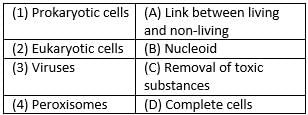Lakhmir Singh & Manjit Kaur Test: The Fundamental Unit of Life - Grade 9 MCQ
19 Questions MCQ Test - Lakhmir Singh & Manjit Kaur Test: The Fundamental Unit of Life
Match the following with the correct response.


Functional segments of DNA are called
Which organelle releases energy?
Eukaryotic cells have
A. Distinct nucleus
B. Nucleolus
C. nuclear membrane
D. Nucleoid
“All cells arise from pre - existing cells” who said this?
Match the following with correct response.

Animal cell lacking nuclei would also lack in
What is the full form of ATP?
The passage of water from a region of higher water concentration through a semi – permeable membrane to region of low water concentration is
Which of the following is known as the “fluid substance of cell”?
Which of the following organelles is the smallest in size in prokaryotic cells?
Which organelle is called power of house of the cell-
Root hair absorbs water from soil through
The term protoplasm was coined by
Match the following with correct response.

Ribosomes are the centre for
Which organelle is called the suicide bag of the cell
Which of the following are the main constituents of cell wall?
Which of the following acts as garbage disposal system of the cell?














